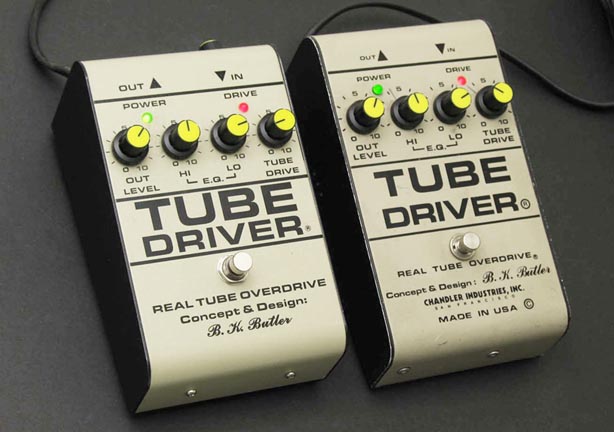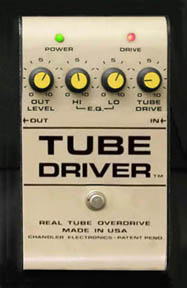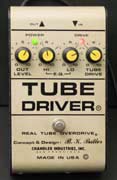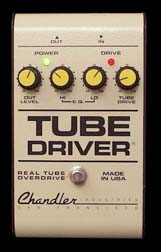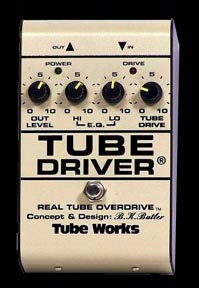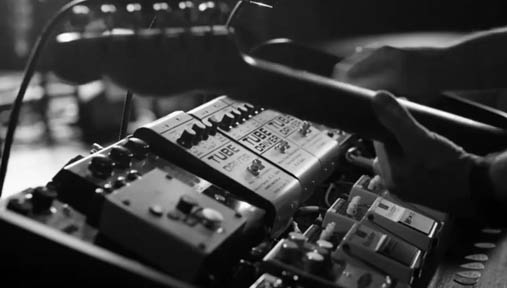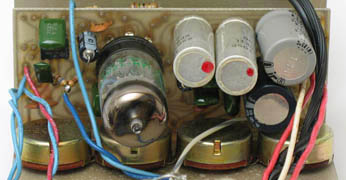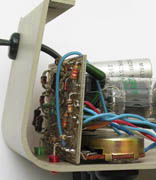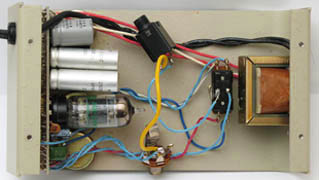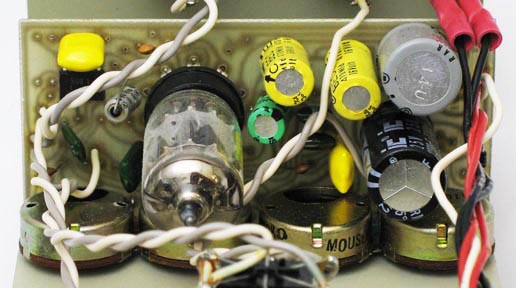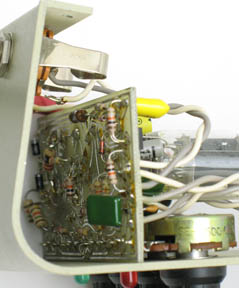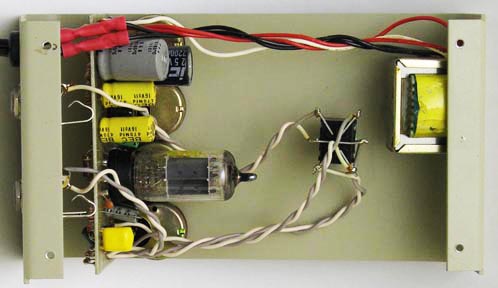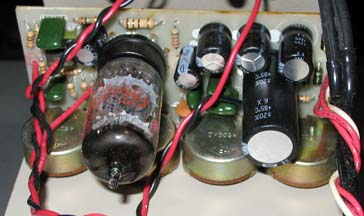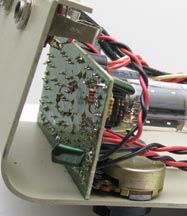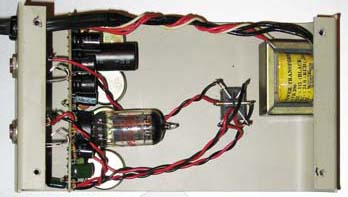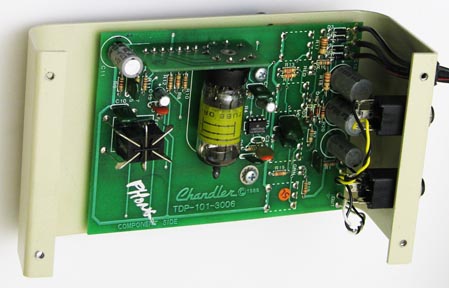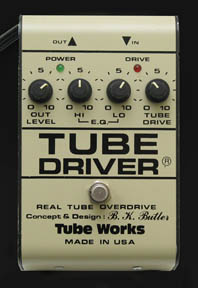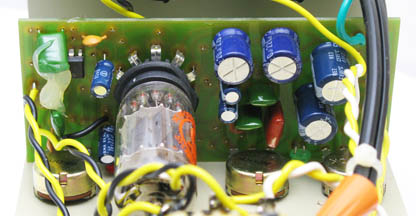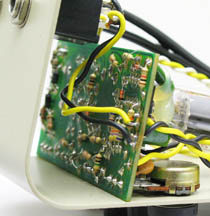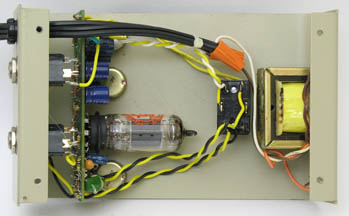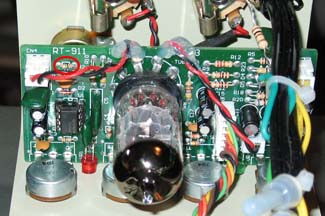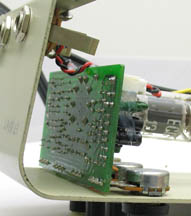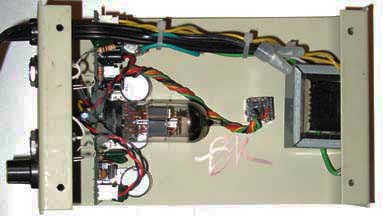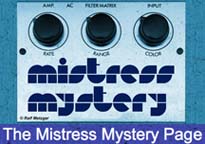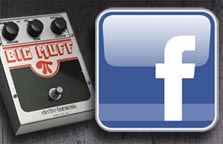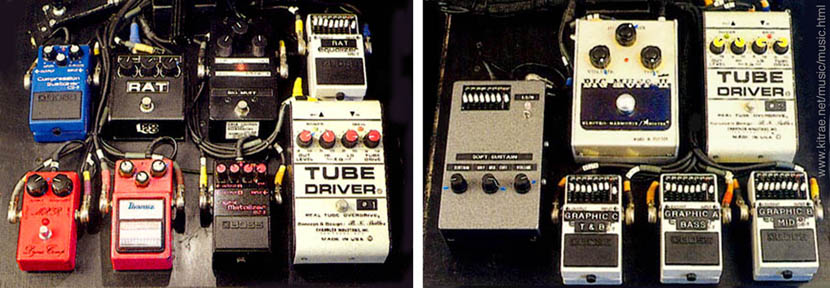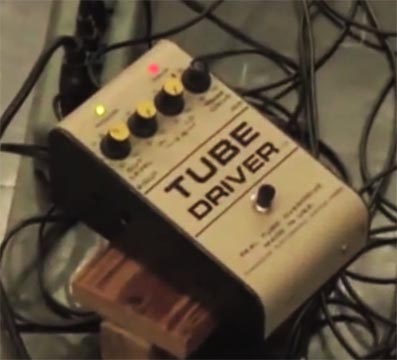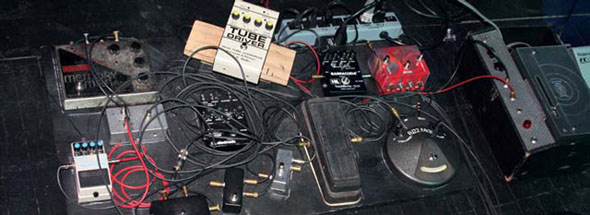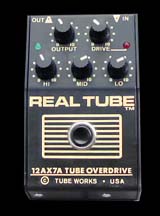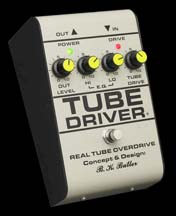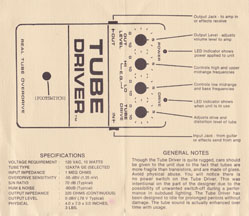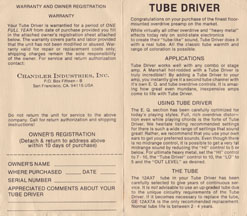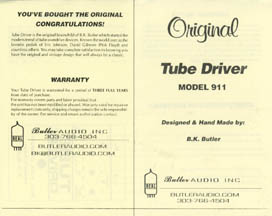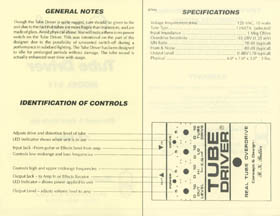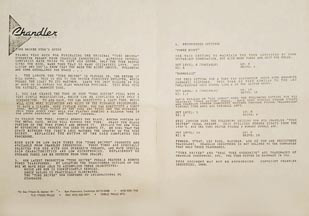Kitís Secret Guitar, Gear, and Music Page
Guitar stuff, gear stuff, soundclips, videos, Gilmour/Pink Floyd stuff, photos and other goodies.
Copyright Kit Rae.
VISIT MY SWORDS, KNIVES and FANTASY ART WEBSITE www.kitrae.net
©Kit Rae. Article written in 2007. Last update January 2023
For the Tube Driver History and Versions article CLICK HERE
For the David Gilmour Tube Driver article CLICK HERE
B.K. BUTLER REAL TUBE OVERDRIVE - The Tube Driver is a booster/overdrive pedal with an IC and vacuum tube driven preamp circuit inside. It has been used by guitarists such as David Gilmour of Pink Floyd, Eric Johnson, J Mascis, Billy Gibbons, Joe Bonamassa, Joe Satriani, David Holt, Keith Urban, Brad Whitford, Kenny Wayne Shepherd, and others. It was designed and built by audio electronics engineer B.K. Butler (Brent Butler). Around 1978 Butler designed and began making an early version of the Tube Driver, one of the first tube overdrive pedals. It has evolved over the years and there are many versions (a list can be found HERE). It generates anything from a smooth, light overdrive tone, to a classic rock-style heavy distortion. At high gain, it is very reminiscent of the lead crunch tone of a Marshall JCM800 amplifier. At low drive it can deliver a Fenderish smooth gain boost or a bluesy overdrive. It is not very versatile sounding through some amps, but exceptionally good with others. It can be difficult dial in a tone setting that hits the sweet spot, and some people find it finicky and hard to get along with due to some design issues, but in the right setup, with the right amp, nothing sounds quite like it. The TD has a very unique voice that I have never heard another overdrive replicate.
The Tube Driver looks like something from the bridge of the Enterprise from the 1960s Star Trek television show. The standard 4 knob version features a LEVEL (volume control), HI (treble), LO (bass), and DRIVE control. The 5 knob version adds a MID knob. Inside is a hybrid fuzz - pre amp circuit. The clipping part of the distortion comes from the integrated circuit chip, or op-amp. That strong signal is fed into a vaccuum tube, which does not work to amplify the signal the same as it would in the pre amp stage of a typical amplifier. It filters and colors the sound with the tube characteristics. The circuit only draws about 30mA and the tube is actually only running at 12v, a fraction of what these tubes run in a typical amplifier. This is called a "starved plate" design, and you won't see much tube glow, if any, if you look inside. It would seem that the tube itself would make very little difference to the sound, but it actually is an integral part of the sound, and different tubes or tube types can alter the sound in different ways at very low drive settings. Butler has always made these stock with 12AX7 tubes, but owners often experiment with different tube types to tailor the tone.

I think the TD sounds best with clean amps that have a healthy mid range, like the Hiwatt Custom 50 or Custom 100 (DR103), or similar amps like the Reeves Custom 50/100. It also sounds excellent with certain Fender amps, particularly the Fender Bassman, or it's high powered step brother, the Marshall JTM-45. The four knob Tube Driver sounds best with amps that have a moderate mid range. For mid-scooped amps, like the Fender Twin Reverb, the Real Tube version with the mids knob is better. Some amps that do not have a lot of head room and break into distortion at high volume do not play well with it. It also does not sound good when certain pedals are before or after it in the signal chain dues to the high impedance output. Unlike typical effect pedals, the Tube Driver includes a built in power cord, as it uses an internal transformer, which can be noisy for certain users.
They’re unique sounding. They don’t sound like the Boss pedals at all. They don’t sound like any other pedal manufacturer…and they don’t even sound like the new (911) ones. They are just so unique sounding. It took a long time to decide which is my favorite one that I would say is my go-to one, let’s say for making a record. All this stuff had my writing on it. I even wrote my name on it from the early tours because we kept getting our pedals stolen all the time. That particular one, in my mind, has that unique singing quality to it. Just the right amount of compression, so you can play stuff that’s really low and stuff that’s really high. That’s the one I used to record the title track Surfing’ with the Alien. I used it for the beginning of Satch Boogie, that into the Marshall. When you set up the clean channel and send the volumes up…so you put that together with a Tube Driver and you’re there. You’re in the late ‘60s playing the Royal Albert Hall and you’re playing way too loud! - guitarist Joe Satriani from a 2021 ikmultimedia interview
TUBE DRIVER VERSIONS - There have been numerous version of the Tube Driver made since the 1980s, but these are all of the 4 knob versions. A mostly complete list of all the other versions can be found HERE.
•1985 - B.K. Butler/Chandler Tube Driver. Marked TUBE DRIVER™ and CHANDLER INDUSTRIES-PATENT PEND. on the front.
•1986-87 - B.K. Butler/Chandler Tube Driver. Marked TUBE DRIVER®, Concept & Design: B.K. Butler and CHANDLER INDUSTRIES, INC on the front.
•1988 - Chandler Tube Driver. Knockoff made by Chandler after Butler parted ways with them. Only marked with script Chandler logo on the front, no BK Butler.
•1993-94 - 911 Tube Driver - Made by Butler's Tube Works company. A four knob version of the Tube Works 901 Real Tube pedal, which was an improved Tube Driver.
•2005 - 911 Tube Driver. A reissue of the 1990s Tube Works Tube Driver.
Shown above - An extremely rare original 1985 Tube Driver with input and output jacks on the sides and slightly different graphics than later models.
Shown above (left to right) - The 1985 BK Butler Tube Driver, the revised 1986-87 BK Butler Tube Driver, the unauthorized 1988 knockoff made by Chandler after Butler parted ways with them, the 1990s Tube Works 911 Tube Driver, and a B.K. Butler reissue of the 911 Tube Driver from 2006.
I think I have probably owned nearly every version of Butler's Tube Driver, including several original Chandler/BKB versions from the 1980s, the 1989 Real Tube version with 5 knobs, the 911 model, the 911 reissues, the 1996 Ibanez Tube King, and the Tube Works Smooth pick pedal, among others. I have played most of the other variants as well and I suggest staying away from any but the original 4-knob Tube Drivers branded with both BKB and Chandler, Tube Works branded 911 Tube Drivers made in the USA, the USA made Ibanez Tube King, or the BKB Branded 911 Tube Drivers made since 2006. The three knob version may be found for much less money but it is a simplified version of the circuit and can be difficult to make sound good on certain amps. There are also Taiwan-made versions that may or may not sound the same as their USA made counterparts. I do not recommend the knockoff Chandler version with the attached wall wart either (the one without BK Butler's name on it), as those have a different tone circuit that sounds different than the BKB circuit, although some people like it.
Various versions of the B.K. Butler Tube Driver
Top row (left to right) - the Chandler knockoff from 1988, three BKB/Chandler Tube Drivers from 1986-87, and an Ibanez Tube King (TK999US) from 1995.
Bottom row (left to right) - a BK Butler 911 Tube Driver reissue from 2007, a 911 reissue with bias knob on back from 2008, an original 911 Tube Driver from 1994, a 901 Real Tube from 1987, and a 903 Smooth pick pedal from 1997
There are three different circuit boards used in the original BKB/Chandler 1985-87 Tube Drivers. The first one had a light tan colored pcb with components of both sides, marked 93151. The second version had a slightly revised pcb layout, and was marked 93151-Z. I have seen two slightly different sets of component values on that board, and in my experience, and based on what other owners have said, the sound can vary from one to another. I have played four side-by-side. Two of them sounded identical to each other (and identical to third version mentioned below) and the other two sounded very different.
Butler had a firm in California manufacture a third circuit board for him sometime in 1987. The trace side was dark green on this version and most components were soldered on the front side, but a few caps and resistors were on the trace side. It had no identifying numbers or letters, and I have seen two slightly different sets of component values on this pcb. I have owned several of this version and each sounded nearly identical.
In 1987 Butler made made what he considered an improved version called the Real Tube through his Tube Works company. It added a mids knob, allowing a strong mid boost to be dialed in, getting into the Tube Screamer territory. It had a much wider tone range than the earlier 4 knob versions. With the mids knob dialed almost off, the tone range is basically the same as the 911 Tube Driver Butler made in the 1990s, and the 911 reissue he began making in 2005. The 5 knob Blue Tube Enhancer (model 903) and Smooth pick pedal (model 303) are lower gain versions of the same circuit, suitable for mid gain overdrive and rhythm playing, or boosting an amp or high gain pedal.
Various versions of the Tube Driver
Top - the Mini Boogee from 1981
Middle row (left to right) - Chandler Tube Driver knockoff from 1988, Dean Markley Overlord (Real Tube knockoff) from 1988, 901 Real Tube from 1990s (Genz Benz), Tube Works gold Blue Tube from 1980s, 901 Real Tube from 1987, 903 Smooth pick pedal from 1997
Bottom row (left to right) - 1985 BKB/Chandler Tube Driver, 1986 BKB/Chandler Tube Driver, 911 Tube Driver from 1994, 911 Tube Driver from 1987, 910 Tube Driver from 1994
Around 1993 Butler made a new version of the older 4 knob Tube Driver through his Tube Works company, called model 911. It was basically the Real Tube circuit without the mid range knob, not the older BKB/Chandler circuit from the 1980s. The circuit layout and pathways were very similar to the 1980s circuits, but there were several component value changes across the circuit that affect the way it sounds. Butler sold the Tube Works company in the 1990s and it was later shut down. In 2006 Butler reissued the 911 Tube Driver by custom order through his Butler Audio company. This version was used by many popular guitarists, most notably David Gilmour of Pink Floyd, who used them in his 2006 On an Island tour pedal board and 2015/16 Rattle That Lock tour pedal board.
In 2008 Butler added began offering a Bias control option, something he offered on the very first Tube Drivers in the 1980s. The TD comes stock with a 12AX7 tube. The bias knob allows you to reduce the gain, similar to what would be accomplished by changing to a lower gain tube like the 12AU7. The full + setting is the same as the non bias version, but I found that rather than softening the distortion with the bias reduced, it tended to make the sustain die faster. I found it more effective to simply change to a lower gain tube, but others really like this feature.

B. K. Butler
B.K. Butler still makes 911 Tube Drivers by hand (at the time this article was written) through his Butler Audio company, HERE. Used models are also plentiful and easy to find online. If you want to read more about B.K. Butler and the Tube Driver, there is a good interview over on the fantastic Tone From Heaven website. A list of most of the Tube Driver versions can be found HERE. You can read more about David Gilmour's Tube Driver HERE
Here’s a unique thing about the Chandler Tube Driver... basically it’s set up like a preamp for a vintage amp…your signal goes in, the whole signal gets tweaked, and it comes out as one whole piece. No mixing of the original (clean) signal. All the other famous overdrive pedals and Tube Screamers, whether they have tubes in them or not, those are mixed. So that’s the clipped signal mixed with the straight. So you can use that straight signal coming out of your Tube Screamer and you can run it into the Chandler, and you are actually feeding your Chandler some new “fresh guitar”, so to speak. And then you can dial back its gain and take advantage of its sweet compression, or its unique EQ curve, that perhaps the overdrive pedal you are using for your main gain doesn’t have as much. - Joe Satriani 2021 ikmultimedia interview
SOUND CLIPS - These are almost all Pink Floyd/David Gilmour inspired tone clips. With just a light drive setting the TD works great with a neck pickup for solos and blues playing. It is perfect for songs like Shine on You Crazy Diamond and Coming Back to Life. The sound holds its own against a Big Muff when cranked into full overdrive. Here are clips of different Tube Drivers played with a Stratocaster fitted with EMG-SA pickups through a Fender Twin Reverb and a Reeves Custom 50 (Hiwatt Custom 50/DR504 replica), and a P-90 Les Paul into a Reeves or Fender Bassman. You can read more about David Gilmour's Tube Driver HERE
![]() Bridge of Sighs - Strat into a 1980s Tube Driver > Boss CS-2 compressor > TD > Mojo Vibe (Univibe clone) > Future Factory delay > Ambi Space plate reverb > Reeves Custom 50
Bridge of Sighs - Strat into a 1980s Tube Driver > Boss CS-2 compressor > TD > Mojo Vibe (Univibe clone) > Future Factory delay > Ambi Space plate reverb > Reeves Custom 50
![]() Time Solo - Strat into a 911 Tube Driver > Future Factory delay > Reeves Custom 50
Time Solo - Strat into a 911 Tube Driver > Future Factory delay > Reeves Custom 50
![]() Fat Old Sun solo - Telecaster into a 911 Tube Driver > Future Factory delay > Reeves Custom 50
Fat Old Sun solo - Telecaster into a 911 Tube Driver > Future Factory delay > Reeves Custom 50
![]() In Any Tongue solo - Demeter Compulator >Tube Works 911 Tube Driver > Deluxe Electic Mistress (70% mix) >Future Factory Delay > Ambi Space Plate Reverb > Reeves Custom 50
In Any Tongue solo - Demeter Compulator >Tube Works 911 Tube Driver > Deluxe Electic Mistress (70% mix) >Future Factory Delay > Ambi Space Plate Reverb > Reeves Custom 50
![]() Pigs Outro solo - Tube Works 911 Tube Driver > Future Factory Delay > Ambi Space Plate Reverb > Reeves Custom 50
Pigs Outro solo - Tube Works 911 Tube Driver > Future Factory Delay > Ambi Space Plate Reverb > Reeves Custom 50
![]() Castellorizon - BKB 911 Tube Driver > EMG Strat, TC Nova delay into a Reeves Custom 50.
Castellorizon - BKB 911 Tube Driver > EMG Strat, TC Nova delay into a Reeves Custom 50.
![]() Calling Part 2 (guitars) - 1980s BKB/Chandler Tube Driver > Boss CE-2 Chorus > TC Nova delay into Fender Bassman. Stratocaster with EMG pickups and E-bow.
Calling Part 2 (guitars) - 1980s BKB/Chandler Tube Driver > Boss CE-2 Chorus > TC Nova delay into Fender Bassman. Stratocaster with EMG pickups and E-bow.
![]() Louder Than Words solo - Boss CS-2 Compressor > BKB/Chandler Tube Driver 12AX7 tube > Future Factory Delay > Ambi Space Plate Reverb > Reeves Custom 50
Louder Than Words solo - Boss CS-2 Compressor > BKB/Chandler Tube Driver 12AX7 tube > Future Factory Delay > Ambi Space Plate Reverb > Reeves Custom 50
![]() BKB/Chandler Tube Driver - Light drive/boost demo. TC Nova delay. 12AU7 tube.
BKB/Chandler Tube Driver - Light drive/boost demo. TC Nova delay. 12AU7 tube.
Clips below are played with a 2008 American Standard Strat, Seymour Duncan SSL-5 bridge pickup, Fender CS69 neck pickup, or Seymour Duncan SSL-5 bridge pickup, into a '65 Fender Twin Reverb RI or a Reeves Custom 50.
LIGHT DRIVE / BOOST SETTING - Example of the Tube Driver light drive setting with a Fender Strat into a Reeves custom 50. Settings shown above.
![]() MP3 Sound Clip - Tube Driver light boost setting, Boss CE-5, and Nova delay. 12AX7 tube.
MP3 Sound Clip - Tube Driver light boost setting, Boss CE-5, and Nova delay. 12AX7 tube.
OVERDRIVE SETTING - Example of the Tube Driver overdrive setting with a Fender Strat into a Fender Twin Reverb. Settings shown above.
![]() MP3 Sound Clip - This is just the TD with 12AX7 tube and some delay from a TC Electonic Nova delay.
MP3 Sound Clip - This is just the TD with 12AX7 tube and some delay from a TC Electonic Nova delay.
CAN A TUBE DRIVER HANDLE LEADS LIKE A BIG MUFF? - It can, and David Gilmour has been using the Tube Driver as his main distortion since his 2006 On an Island tour finished (according to him and his backline tech), and his TD overdrive settings from the same tour produced a very muffish distortion. It does a great lead tone, although it does not have quite the same huge bottom end and scooped mid range you find in a Ram's Head era Big Muff. I was going for Gilmour's Pulse era live tone in the clip below. A 'Civil War' Sovtek Big Muff was used for the song Sorrow, so I'm using the Tube Driver here to compare to a Muff. Strat into a Fender Twin Reverb.
BOOSTING A BIG MUFF WITH A TUBE DRIVER - A Tube Driver can be used as a light boost before or after a Big Muff in the signal chain. Muffs like to be driven hard and like a loud, clean tube amp to sound good, but sometimes that is not enough for lead playing or solos, especially with modern Muffs. By 'boost' I don't mean a volume boost, but more of a blend of the two pedals. Driving a Muff with a Tube Driver can make the tone come alive, smooth out the tone while adding some gain and mids, and help it cut through in a band mix better. Most modern Muffs and some vintage Muffs can really benefit from this type of boost. The Big Muff sound is slightly warmer when placing before a Tube Driver, and slightly sharper/harsher when placing it after. The tone of a Tube Driver is fairly transparent when using as a boost, but you can also lightly color the Muff tone when boosting.
BIG MUFF BOOST (settings shown above)
Tube Driver set for boost AFTER a Civil War Big Muff - smooth tone
![]() MP3 Sound Clip - Boss CS-2 Compressor > Tube Driver > Big Muff
MP3 Sound Clip - Boss CS-2 Compressor > Tube Driver > Big Muff
Tube Driver set for boost BEFORE a Civil War Big Muff - grittier tone
![]() MP3 Sound Clip - Boss CS-2 Compressor > Big Muff >Tube Driver
MP3 Sound Clip - Boss CS-2 Compressor > Big Muff >Tube Driver
OLD 1986-87 ERA B.K. BUTLER/CHANDLER TUBE DRIVER VS 2000s ERA B.K. BUTLER TUBE DRIVER - The core circuit design on the 2000s reissue 911 Tube Driver is similar to the original 1985-87 versions, but there were several component value changes across the circuit that affect the way it sounds, as well as different pots. Do they sound different from each other? Tube Drivers of different eras can sound slightly different from each other anyway, primarily because of differences in the way different tubes filter the sound, but also because of how the circuits were slightly revised over the years, and how the components have aged. There was a 1985-87 circuit (with two variations), a 1987 circuit (with two variations), a model 911 circuit board from the 1990s, and a reissue of the 911 that Butler started making around 2005. Each requires different settings to sound the same. However, when using the exact same tube, each can be dialed to sound nearly identical, with the exception of some of the 1985-87 models. If we look at the more common circuits from 1987, the LEVEL, HI, LO, and DRIVE knobs need to be set very differently to get the same tone on a 911 or 911 reissue Tube Driver. The photos below illustrate the differences using a typical 1987 Tube Driver and a 2007 reissue model 911 Tube Driver.

Light drive settings for the common 1987 BKB/Chandler Tube Driver and settings to match the same tone on a 2007 model 911 Tube Driver

Overdrive settings for the common 1987 BKB/Chandler Tube Driver and settings to match the same tone on a 2007 model 911 Tube Driver
The primary difference is much more low end available in the 2007 version than the 1987 version, so it can be dialed into much heavier, fatter tones. There is slightly more drive/gain available on the 2007 TD when set to 10 than most of the 1980s TDs. The 2007 TD offers drive/gain all the way from 1-10, whereas on most of the the older TDs there is no volume at all until the drive gets up to around 2. The 2007 TD also has "notched" pots, like the Tube Works versions, meaning you feel tiny notches click by as you turn the knobs. Notches 1-2 do little on the 2007 TD drive knob, then at notch three there is a huge jump in volume and drive.
Below are a few comparison clips. These clips are not the correct overdrive settings for Shine On You Crazy Diamond, just what I had set at the time I banged them out. The drive is set around 85%. Both TDs use the same GE brand 12AX7 tube. Strat into a fender Twin Reverb.
![]() MP3 Sound Clip - BK Butler/Chandler Tube Driver from 1980s
MP3 Sound Clip - BK Butler/Chandler Tube Driver from 1980s
![]() MP3 Sound Clip - BKB Butler Tube Driver made in 2007
MP3 Sound Clip - BKB Butler Tube Driver made in 2007
Shown Above - The original 1985 BKB/Chandler Tube Driver circuit with components on both sides
Shown Above - The second version of the BKB/Chandler Tube Driver circuit from 1986-87 with components on both sides
Shown Above - The third version of the BKB/Chandler Tube Driver circuit from 1987 with most components on the front side
Shown Above - The unauthorized 1988 Chandler Tube Driver knockoff with a different tone stage
Shown Above - A 1994 Tube Works model 911 Tube Driver
Shown Above - A 2007 BKB Tube Driver circuit with bias knob option, which was a reissue of the 911 Tube Works Tube Driver, not the 1980's Tube Driver
REAL TUBE by TUBE WORKS - Other than one being in super cool enclosure, and the other in a butt-ugly enclosure, the 4 knob 911 Tube Drivers and 5 knob Real Tube versions are basically the same patented B.K. Butler designed Tube Driver circuit with some component differences. The Real Tube includes a mid range knob, allowing for a wider range of tones to be dialed in. In that way, it is actually a more versatile pedal than the 911 Tube Driver, and housed in a smaller enclosure. It is powered by an internal transformer and includes a power cord like the Tube Driver. There was a USA made version by Tube Works beginning in 1987, and a Taiwan version made when Tube Works was sold to Genz Benz in the 1990s. The only real difference between the two was less expensive, cheaper parts in the Taiwan version. Some of those Taiwan pedals were made with a 9v or 12v DC power jack on the back, rather than a built in power transformer and AC cord on the earlier models.
IBANEZ TUBE KING TK999US - This is another B.K Butler design, made by his Tube Works company for Ibanez. It is basically the 5 knob Real Tube circuit with a few changes and improvements, like an active tone circuit rather than the passive circuit in the Real Tube. Unlike the 911 Tube Driver and Real Tube, the Tube King includes an output buffer so it is immune to most capacitance and loading issues that can plague those other pedals. It also runs off a standard 9v DC power jack, not an internal transformer, so noise issues associated with the internal transformer in the Tube Driver and Real Tube have been eliminated. When using the same tube, it can sound 90% the same as the Real Tube or 911 Tube Driver. The pcb includes the Butler patent number 5022305. Note: there were two versions, one from Tube Works that was made in the USA, and one made in Japan by Maxon for Ibanez and Maxon branded versions that were sold internationally. The Japanese version does not follow Butler's circuit.
4 KNOB 911 TUBE DRIVER vs 5 KNOB REAL TUBE - Other than the mid range knob, do the Real Tube and 4 knob 911 Tube Drivers from the 1990s and 2000s sound any different? Tube Drivers can sound slightly different from each other anyway, primarily because of differences in the way different tubes filter the sound and circuit variations, but when using the exact same tube, the 911 and 5 knob Real Tube versions can both dial in nearly identical tones. The US made version of the 5 knob Ibanez Tube King is also based on the Real Tube circuit and sounds very similar.



The photos above show what the Real Tube and Tube King settings need to be to match the tone and drive of the 2007 reissue 911 Tube Driver settings on the right
Even when using the exact same tube, the same knob settings on the Real Tube and Tube King will NOT result in a matching tone and drive on the 4 knob 911 Tube Drivers built after 2005. To get the Real Tube and Tube King mid range to match the pre set mid EQ in the 911 Tube Driver you have to dial the MID knob down to around 9:00. The highs and lows on the Real Tube and Tube King are also notched a bit differently than the 911. The photos above show what the Real Tube and Tube King settings need to be to match the tone and drive of the 911 Tube Driver settings on the right.
Shown Above - Kenny Wayne Shepherd pedalboard circa 2012 with a 2006 era 911 Tube Driver
DAVID GILMOUR TONES - David Gilmour has been an avid Tube Driver user since the 1990s. He first used them for the recording sessions for Pink Floy's Division Bell album in 1993. Those same sessions also resulted in Pink Floyd's The Endless River album, which was not completed until 2015. He used 911 Tube Drivers extensively for his 2006 album On an Island and the subsequent tour, heard on the Remember Than Night and Live in Gdansk concert releases, as well as his 2015 Rattle that Lock album and tour. I have a page about Gilmour's various Tube Drivers and settings HERE.
David Gilmour's 1994 Pink Floyd pedal board with two 1986-87 era BKB/Chandler Tube Drivers labeled #1 and #2. A page about Gilmour's Tube Drivers can be found here HERE
ERIC JOHNSON TONES - Eric was the first well know user of the Tube Driver back in the 1980s. Listen to Johnson's Cliffs of Dover from his 1990 album Ah Via Musicom for an example of his 1980s Tube Driver into a 100w Marshall amplifier. Four different Tube Drivers have been seen in his recording studio. He owns one of the first Tube Drivers made by Butler in 1985, which is marked Chander Electronics - Patent Pend. on the front, no BK Butler markings. The words Tube Driver are marked with a TM, as the tredemark registration had not gone through yet.
Shown above (left to right) - Eric Johnson's 1985 Chandler branded Tube Driver, his 1986-87 period BKB/Chandler branded Tube Driver (with Chandler blacked out), and his 2005/2006 period BKB branded 911 Tube Driver

Shown above - two versions of Eric Johnson's pedal board with Tube Driverss. He mounts the TDs on a piece of wood so he does not have to bend down far to reach the knobs.
Eric primarily uses the TD as a booster for his 1969 Marshall 100w plexi amps and to add gain to his lead tone through a Marshall JTM-45 or JTM-100 into a Marshall 4 x 12 cabinet. He sets the tone controls off and the drive at around 11:00. This is the setup, as he described it in Guitar Player magazine:
The lead chain goes from a stock, late-’60s Italian-made Vox CryBaby to a stock ’80s BK Butler Tube Driver loaded with a Yugoslavian 12AX7. I set the Tube Driver up on a block because, for some reason, it sounds better set apart from the rest of the pedalboard (Eric later said this was becasue it was easier to reach the knobs). The signal then flows to channels 1 and 2 of a ’69 100-watt Marshall Super Lead. [Settings: Polarity Switch Up, Presence 0, Bass 5, Middle 3, Treble 0, Volume I 9, Volume II 10]. A Monster Cable connects the head to the straight-bottom Marshall 4x12, which is loaded with 25-watt Celestion Greenbacks. - Eric Johnson Guitar Player interview
JOE SATRIANI TONE - Joe was an early user of the Tube Driver. He owns four 1980s era Tube Drivers and still uses them for recording (as of 2021). Listen to the track Surfin' with the Alien from his 1987 album of the same name for a prime example of his TD sound. Joe talked to ikmultimedia about his Tube Drivers in 2021.
I knew Paul Chandler quite well. He was a great guitar player from Oklahoma who had somehow settled in San Francisco in the ‘80s. I probably met him at Gary Browers’ shop, Real Guitars, hanging out there. He and BK Butler really had a great idea about what guitar players needed. I think it was because Paul was a really talented guitar player himself and he knew from experience what a guitar player wanted, from feel, as well as sound.
So I have four of these pedals from that (1980s) era. Every time Paul would make me one, I would come back and say, can you make it do ‘this’. I don’t know what he was doing at the time. I didn’t know much about pedal design, but I think he and BK were playing with the biasing of the tubes and trying some different capacitors here and there. So I wound up with these four that had writing all over them based on what songs they were used for on all the albums… Not of this Earth, Surfing, all the way up to now. We are still using them. - Joe Satriani 2021 ikmultimedia interview
I listened a lot of Joe Satriani in the late 1980s and always wondered how he got that guitar tone for the title track on Surfin' with the Alien. Joe described his setup for the song in Vintage Guitar magazine.
I used a Kramer Pacer (guitar) made from spare parts… The tone on the title track is so big, throaty, and dry. It was the Kramer into a Vox wah and a Chandler Tube Driver into a Marshall half-stack. We used an Eventide 949 Harmonizer for the pitch-shift effect.
In 2017 Joe gave an interview to Music radar, with a track-by-track details of the Surfin' with the Alien album. It included a much more detailed description of the setup and recording for the title track.
I was using that Black Boogie Strat into a very early Chandler Tube Driver. I had three or four of them at the time, and I would go right into an early-'70s Marshall 100-watt head, into a 4x12, and that's how we pretty much did that particular song. And we just made adjustments to the amount of distortion that was generated from the Chandler Tube Driver. I got to the studio, I remember I said, ‘I've got this (Vox) wah-wah pedal’...So I plugged that into the Tube Driver and that's going into the Marshall, and then we said, ‘We need something else.’ So he (producer John Cuniberti,) goes, ‘Well, we've got this Eventide 949 [Harmonizer] here.’ And John dials up that weird stereo sound where it was like a straight signal on the left and I think on the right it was like minus 11 cents or something like that.
We had 20 minutes left of the session that afternoon at Studio C in Hyde Street, and we were so excited with the sound, we did this one big pass from the beginning all the way to the end...Then we had to break down entirely, which means strip the amps, the microphones, everything. So the sound was lost. The next time we were in the studio a couple of days later...we just did the solos. The solos are all separate sounds for all the different keys...- Joe Satriani 2021 ikmultimedia interview
Shown above - J Mascis 5 knob Tube Works Real Tube Overdrives with J's settings, and his four knob 911 Tube Driver.
J MASCIS DIRTY "CLEAN" TONE - J Mascis of Dinosaur jr is another Tube Driver user. He uses the TD for a slightly dirty clean tone in his live rig. It is his always-on sound. He has used the older 5 knob Tube Works versions, and the modern four knob BKB version. Both are shown above with J's settings. J was spotted using the modern four knob version on his 2011 board, into a Hiwatt Custom 100 and two vintage Plexi Marshall 100w amp heads, all with Marshall speaker cabinets.

Shown above - Joe Bonamassa's preferred Tube Driver is the Genz Benz 911 version from the 1990s, shown above
JOE BONAMASSA TONE - Joe Bonamassa is also a Tube Driver user, and had this to say on his website: "I have three Tube Drivers and they are all different. Try the Genz Benz one.. that is actually the best in my opinion. Also using a 12AT7 in them helps.." Joe said he used it on the Black Country Communion record. The Genz Benz version was made in Taiwan after Butler sold his Tube Works company to Benz. It can be identified by the 911 model number in the pedal graphics.
Shown Above - ORIGINAL TUBE DRIVER MANUAL from 1987 (thanks to Tom for the scan)
Shown Above - 911 TUBE DRIVER REISSUE MANUAL
Shown Above - 1988 CHANDLER TUBE DRIVER (knockoff) MANUAL
Shown Above - Recommended Settings from the Chandler Tube Driver (knockoff) manual
READING SERIAL NUMBERS - Here is how to read the serial number engraved on the bottom of the BK Butler made Tube Drivers. The first one or two digit are the year made, next two digits are the month, next two digits are the day, and last two digits are the number in the batch.
Older 1980s model Tube Drivers have seven digits. So serial number 6080415 would be:
6 = 1986
0804 = August 4th
15 = 15th made in the batch
Later model Tube Drivers from 2005 and onward have 8 digit serial numbers, so serial number 06071709 would be:
06 = 2006
0717 = July 17th
09 = 9th made in the batch
VISIT MY SWORDS, KNIVES and FANTASY ART WEBSITE 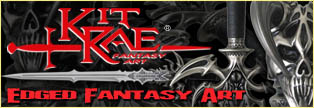 VISIT MY SWORDS, KNIVES and FANTASY ART WEBSITE
VISIT MY SWORDS, KNIVES and FANTASY ART WEBSITE
REPLACEMENT TUBE DRIVER KNOBS - The yellow capped knobs used on the reissue 911 Tube Drivers made since 2005 are unique to B.K. Butler, as he owns the tooling. You can't find those exact knobs unless you buy them direct from him. The various versions of the yellow capped knobs used on the older Tube Drivers were cheaply made and broke easily. The yellow caps were also prone to falling off and becoming lost. It is very difficult to find these same knobs now. Below is a comparison of the different knobs used, and a modern RS Knobs replacement.
RS Components still makes (at the time this was written) a very similar grub screw knob with separate caps, shown below, but it is slightly taller and wider than the TD knobs. www.alliedelec.com also sells the same RS knob and caps. The caps come in several colors, including red, for those of you that want the cool look of David Gilmour's #1 Pulse Tube Driver. They don't exactly fit the older Tube Driver knobs or the smaller knobs used on the 2000s Tube Drivers, but can be modified to fit.
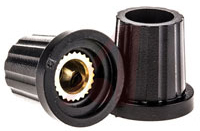


Knobs
RS Stock No. 465-9397
Yellow Caps
RS Stock No. 465-9426
Red Caps
RS Stock No. 465-9432
Rapid Electronocs sells (at the time this was written) more accurate knob and caps, but they are slightly larger than the TD knobs. They are made by Sifam in the UK. They are D shaft knobs, so they would need to be drilled out to make round. Sifam discontinued the round shaft hole version, the TPN150, which I believe was nearly identical to the original Tube Driver knobs.

Knobs: Sifam DCN150
Caps: Sifam C151
